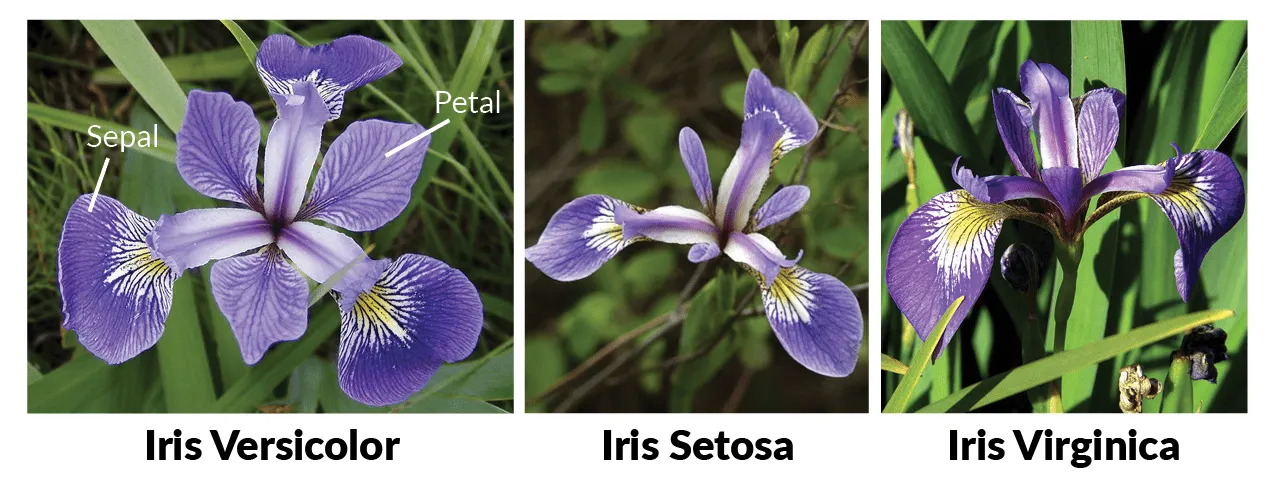| sepal length (cm) | sepal width (cm) | petal length (cm) | petal width (cm) | target |
|---|---|---|---|---|
| 5.1 | 3.5 | 1.4 | 0.2 | 0 |
| 5.7 | 2.8 | 4.5 | 1.3 | 1 |
| 6.7 | 3.3 | 5.7 | 2.1 | 2 |
- Создать проект с новым окружением с помощью poetry
- В терминале:
poetry add fastapi uvicorn[standard] scikit-learn
| endpoint | Тип запроса | Тело запроса | Действие |
|---|---|---|---|
| / | GET | Возвращает сообщение Hello! This is the Iris predictor. |
|
| /class/{class_n} | GET | Возвращает вид, соответствующий n-ому классу | |
| /train | GET | Обучает модель, и возвращает точность предсказания для обучающей и тестовой выборки | |
| /predict | POST | Фичи примера для предсказания {"sepal_length": 0, "sepal_width": 0, "petal_length": 0, "petal_width": 0} |
Возвращает предсказание класса для заданного набора фичей |
В файле main.py
from fastapi import FastAPI
app = FastAPI()
@app.get("/")
async def root():
return {"message": "Hello! This is the Iris predictor."}uvicorn main:app --reload
@app.get("/classes/{class_n}")
async def get_class_name(class_n: int):
species = {
0: "setosa",
1: "versicolor",
2: "virginica",
}
return {"species_name": species[class_n]}Делаем красиво:
Выносим в schemas.py:
from enum import Enum
class IrisSpecies(int, Enum):
setosa = 0
versicolor = 1
virginica = 2Новый метод:
from app import schemas
@app.get("/classes/{class_n}")
async def get_class_name(class_n: schemas.IrisSpecies):
return {"species_name": class_n.name}http://127.0.0.1:8000/docs
В schemas.py:
from pydantic import BaseModel
class ModelMetrics(BaseModel):
accuracy_train: float
accuracy_test: float
class InputFeatures(BaseModel):
sepal_length: float = 0
sepal_width: float = 0
petal_length: float = 0
petal_width: float = 0Теперь пишем обучение модели (model_train.py):
import pickle
from app.schemas import ModelMetrics
from sklearn import datasets
from sklearn.tree import DecisionTreeClassifier
from sklearn.model_selection import train_test_split
def train_clf():
iris = datasets.load_iris()
x_train, x_test, y_train, y_test = train_test_split(
iris['data'],
iris['target'],
random_state=0
)
clf = DecisionTreeClassifier(random_state=0)
clf.fit(x_train, y_train)
accuracy_train = clf.score(x_train, y_train)
accuracy_test = clf.score(x_test, y_test)
with open("app/model.pkl", "wb") as model_file:
pickle.dump(clf, model_file)
return ModelMetrics(
accuracy_train=accuracy_train,
accuracy_test=accuracy_test,
)И добавляем метод в main.py:
from app.model_train import train_clf
@app.get("/train")
async def train():
metrics = train_clf()
return metricsДобавляем формат предсказания в schemas.py:
from pydantic import BaseModel
from typing import Literal
class ModelPrediction(BaseModel):
result: Literal[0, 1, 2]Реализуем предсказание (model_predict.py):
import numpy as np
import pickle
from app import schemas
def predict(data: schemas.InputFeatures):
with open("app/model.pkl", "rb") as model_file:
clf = pickle.load(model_file)
data = np.array(list(dict(data).values())).reshape(1, -1)
prediction = clf.predict(data)
return schemas.ModelPrediction(result=int(prediction[0]))И метод:
from app import model_predict
@app.post('/predict')
async def predict(features: schemas.InputFeatures):
prediction = model_predict.predict(features)
return predictionДобавляем проверку того, что существует файл с моделью:
from app import model_predict
from pathlib import Path
@app.post('/predict')
async def predict(features: schemas.InputFeatures):
if Path("app/model.pkl").is_file():
prediction = model_predict.predict(features)
return prediction
else:
return {"message": "Please train model first!"}